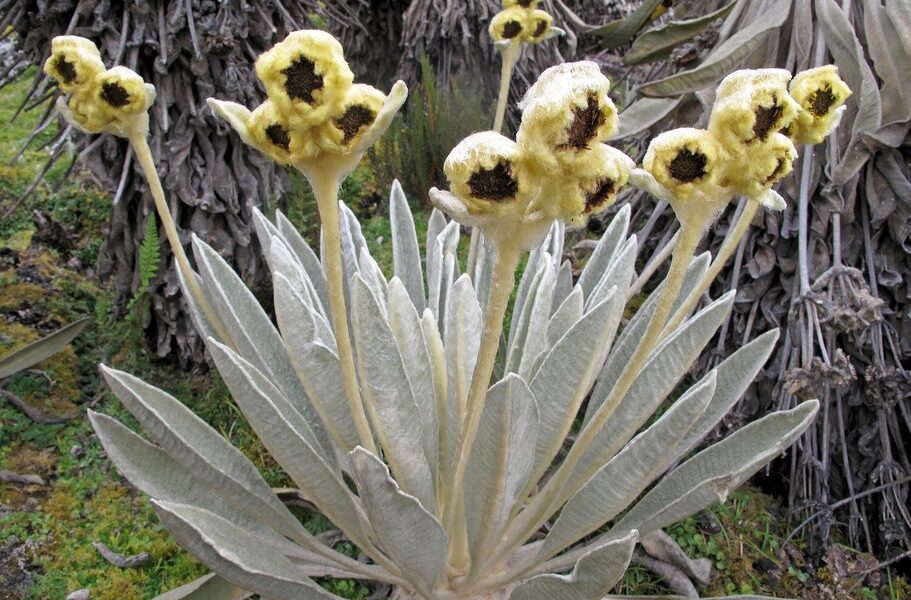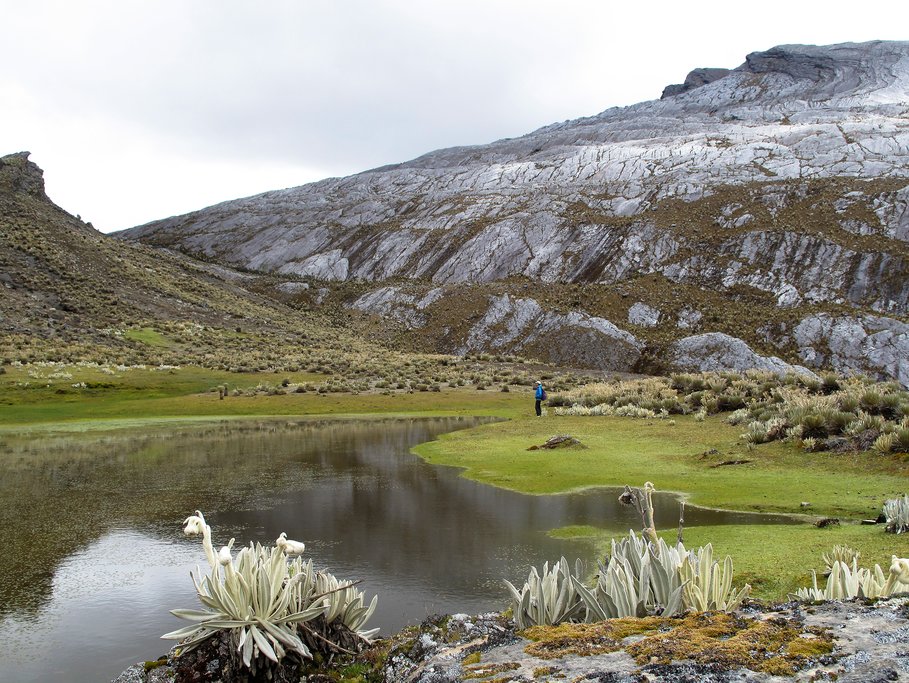
In a country known for tropical jungles and white-sand beaches, the glacial peaks of Parque Nacional Natural El Cocuy stand out. Located north of Bogotá in the beating heart of the Andes, this untamed páramo highland ecoregion holds the best high-altitude hiking in Colombia.
Important Notice: Due to evolving regulations concerning park management and environmental protection, traditional multi-day trekking is currently restricted within Parque Nacional Natural El Cocuy. We are diligently updating this article to reflect the most current information regarding permitted day hiking options and responsible tourism practices. To connect with a specialized travel advisor who possesses up-to-the-minute knowledge about visiting the park and can help you plan an ethical and sustainable trip, please feel free to submit a trip request.
For travelers seeking alternative, yet equally rewarding, trekking experiences within Colombia, we highly recommend exploring the majestic landscapes of Los Nevados National Natural Park and embarking on the captivating Camino Verde treks. These destinations offer stunning scenery and unique cultural encounters.
Overview
The Republic of Colombia boasts a rich tapestry of natural landscapes, preserved within its extensive network of nearly 60 national parks. Each park represents a unique ecosystem, showcasing the incredible biodiversity that Colombia has to offer. From the arid and stark beauty of its deserts to the lush, vibrant life of its Caribbean coastal parks and the immense, verdant expanses of the Amazon rainforest, Colombia’s national parks offer something for every nature enthusiast. However, for dedicated and experienced trekkers seeking a truly challenging and unforgettable adventure, Parque Nacional Natural El Cocuy (also known as Sierra Nevada del Cocuy National Park) holds a particularly alluring appeal. This majestic glacial massif stands as a testament to the raw power and enduring beauty of nature. It’s comprised of two parallel mountain ranges, oriented north-south and stretching for approximately 19 miles in length and three miles in width. This impressive geological formation is adorned with no fewer than 25 snow-capped peaks that pierce the sky. Outside of the vast wilderness of Patagonia, it would be difficult to find more rugged and breathtakingly stunning mountainous landscapes anywhere else in South America. The sheer scale and dramatic beauty of El Cocuy create an unparalleled trekking experience.
That being said, anyone contemplating a journey through this remarkable park must be aware of certain important considerations. This Andean protected area holds deep cultural and spiritual significance, as it is a sacred site for the indigenous Uwa community of Colombia. To respect their traditions and preserve their ancestral lands, the eastern side of the park, which encompasses the indigenous reserve, remains closed to tourism. Therefore, trekking into this area is strictly prohibited. However, rest assured that this guide will provide you with all the essential practical advice and detailed information you need to plan a successful and responsible trek within the permitted areas of El Cocuy. We aim to ensure your adventure goes off without a hitch, while respecting the environment and the local communities.
Planning Your Trip
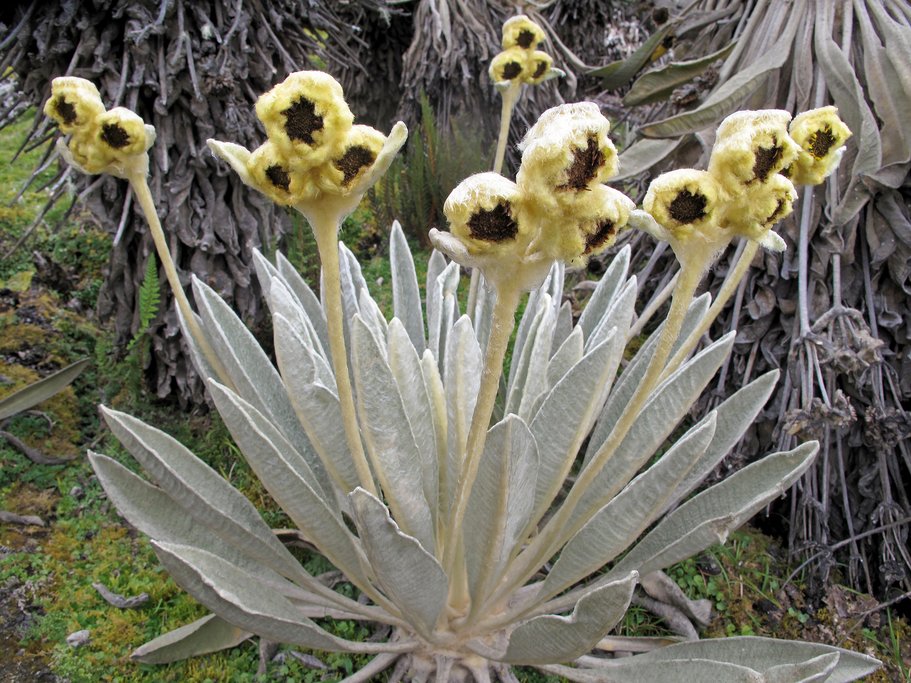
Parque Nacional El Cocuy stands as the largest glacial mass located north of the equator in South America. This geographic distinction means that extreme environmental conditions prevail, and these must be carefully considered when planning your excursion. The high altitude, unpredictable weather, and challenging terrain demand thorough preparation. Adding to the complexity is the fact that there is no accommodation available directly on the main trekking circuit within the park. Lodging is limited to the outskirts of the park. As a result, anyone undertaking a multi-day trek must be fully self-sufficient, carrying all necessary equipment and supplies. If you are planning a day hike, you can manage with a lighter load, focusing on essential cold-weather clothing and sturdy hiking boots. However, for a multi-day trek, you will need to pack a comprehensive array of equipment, including a robust tent suitable for high-altitude conditions, a warm and reliable sleeping bag, cooking gear for preparing your own meals, water purification tablets or a filter to ensure access to safe drinking water, flashlights or headlamps for navigating in darkness, and all other camping necessities to ensure your comfort and safety in the wilderness.
When it comes to clothing, multi-day trekkers need to be prepared for the full spectrum of weather extremes that can occur in El Cocuy. Pack high-quality rainwear, including a waterproof jacket and pants, to protect yourself from sudden downpours. Cold-weather clothing is equally essential, so include items such as a weatherproof jacket, warm gloves, durable hiking pants, and thermal wear or long underwear to provide insulation against the frigid temperatures at higher elevations. The sun’s glare can be intense at high altitudes, so be sure to pack a pair of durable sunglasses that offer adequate UV protection to safeguard your eyes. In terms of equipment, trekking poles can provide valuable stability and reduce strain on your joints, especially when navigating uneven terrain. Sturdy hiking boots with good ankle support are essential for comfortable and safe hiking. Depending on the time of year and the specific areas you plan to explore, crampons may be necessary for traversing snowy or icy terrain. All gear should be tested and broken in before arrival.
When to go
It is generally recommended that travelers avoid visiting during peak holiday periods, particularly from Christmas through the first two weeks of January. During these times, the limited campsites can become excessively crowded, diminishing the wilderness experience. To minimize your exposure to heavy rains and maximize your chances of enjoying clear weather, plan your visit during the driest months of the year. These typically fall between December and April, as well as July and August. However, it is important to note that even during the dry seasons, you can still expect to encounter some amount of rain and fog, particularly at higher elevations. Therefore, it is essential to pack your rainwear, regardless of the time of year you choose to visit. The unpredictable nature of the weather in El Cocuy is part of its charm, but it also requires careful preparation.
Altitude
The majestic mountains within Parque Nacional El Cocuy reach impressive altitudes, ranging from approximately 16,000 feet to a towering 17,500 feet above sea level. These high elevations pose a significant risk of altitude sickness, a potentially debilitating condition that can affect even the most experienced trekkers. To mitigate this risk, it is highly recommended that you arrive in the capital city of Bogotá well in advance of your trek to allow your body time to acclimatize to the higher altitudes. Bogotá itself sits at an altitude of 8,661 feet, providing a gradual introduction to the thinner air. During your trek, avoid rushing your ascents and allow your body to adjust to the changing altitude. Above all else, be sure to stay adequately hydrated by drinking plenty of water throughout the day. Dehydration can exacerbate the symptoms of altitude sickness. Listen to your body, and if you experience any symptoms, such as headache, nausea, or dizziness, descend to a lower altitude immediately.
Those planning multi-day treks deep into the park can further acclimatize by spending a night or two in one of the last outposts before reaching the park entrance. These outposts typically consist of local fincas (traditional country homes) and villagers’ cabanas, offering basic but comfortable accommodation. These lodgings are usually situated at altitudes between 11,000 and 13,000 feet, providing a valuable opportunity for your body to adjust to the thinner air before venturing higher. If you have booked your trek through a reputable tour company, your itinerary will typically include a stay at one of these locations as part of your ascent into the park, prioritizing your acclimatization and well-being.
Weather
To put it mildly, the weather conditions in Parque Nacional El Cocuy can be described as highly variable and often unpredictable. As previously noted, even during the designated dry seasons, you should anticipate intermittent rainfall at any time of day. The same holds true for the presence of fog, which can roll in quickly and significantly reduce visibility, especially at higher elevations. This is precisely why, even though the hiking trails within Sierra Nevada el Cocuy are generally well-marked, we strongly advise that first-time visitors hire a local, experienced guide. A knowledgeable guide can prove invaluable in navigating through conditions of low visibility, ensuring your safety and preventing you from getting lost. Moreover, a guide can provide assistance with other practical considerations, such as identifying safe water sources and selecting appropriate campsites. We will elaborate further on the benefits of hiring a guide below.
Trekking Cocuy with a guide
Given the absence of accommodation facilities within the boundaries of the park, it is crucial to possess the necessary knowledge and skills to identify suitable locations for setting up camp and to locate reliable sources of drinking water. Furthermore, navigating the intricate network of trekking paths can be challenging, particularly when faced with adverse weather conditions. For these compelling reasons, we strongly recommend that you consider trekking with a local guide who is intimately familiar with the terrain, weather patterns, and potential hazards of the park. Arranging for a guide can be easily done in the towns situated just outside the park’s perimeter. In addition to assisting with practicalities, local guides can enrich your experience by providing fascinating insights into the diverse flora and fauna of the region, as well as sharing their knowledge of local indigenous culture and traditions. Their expertise can transform your trek from a simple hike into an educational and culturally immersive adventure. Hiring a local guide is a responsible way to support the local economy.
Chat with a local specialist who can help organize your trip.
Arriving in Parque Nacional El Cocuy
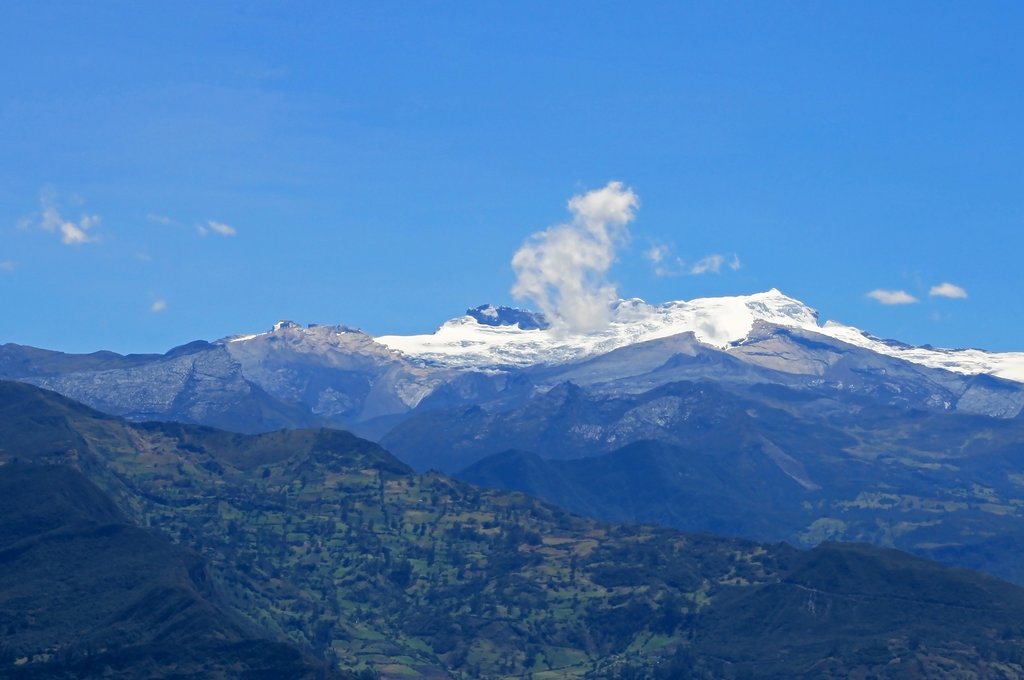
From a logistical standpoint, Parque Nacional El Cocuy enjoys relatively easy accessibility from the bustling capital city of Bogotá. Trekkers typically begin their journey to the foot of the park from either the small town of El Cocuy itself or from the town of Güicán, located approximately six miles to the north. Securing entry permits to Parque Nacional El Cocuy is a mandatory requirement, but the process is straightforward and permits can be readily obtained from the park offices located in either of the aforementioned towns. It is worth noting that the economies of both El Cocuy and Güicán are heavily oriented towards supporting excursions into the park. In El Cocuy, for example, you will find readily available maps of the park, opportunities to arrange for experienced local guides, and, for first-time visitors who may lack a clear frame of reference, a detailed mini-scale model of the park’s mountainous terrain situated prominently in the main plaza.
Regarding transportation options, several bus companies offer services from Bogotá heading north towards El Cocuy. The journey typically takes between 11 and 12 hours, although delays can sometimes occur. Buses typically depart twice a day, with one morning bus and one evening bus. However, it is important to note that bus schedules are subject to frequent changes, so it is advisable to check the latest schedules in advance to avoid any inconvenience. Upon arriving in either El Cocuy or Güicán, the next step is to plan your transportation to one of the local cabanas (rustic cabins) that serve as the primary embarkation points for entering the park. From the town of El Cocuy, you can hike for approximately 4-5 hours to reach Cabañas Guaicany, situated at the southern entrance to the park. Alternatively, you can head to Finca la Esperanza, which offers the most direct access to the stunning Laguna Grande de la Sierra. For a quicker arrival, you can catch an early morning milk truck, which typically departs around 6 am from the main plaza in El Cocuy. Private transportation options are also available and can be arranged at the plaza for added convenience. Plan all connections in advance to avoid any delays and ensure a seamless transition to the park.
Cocuy’s Top Sights and Activities
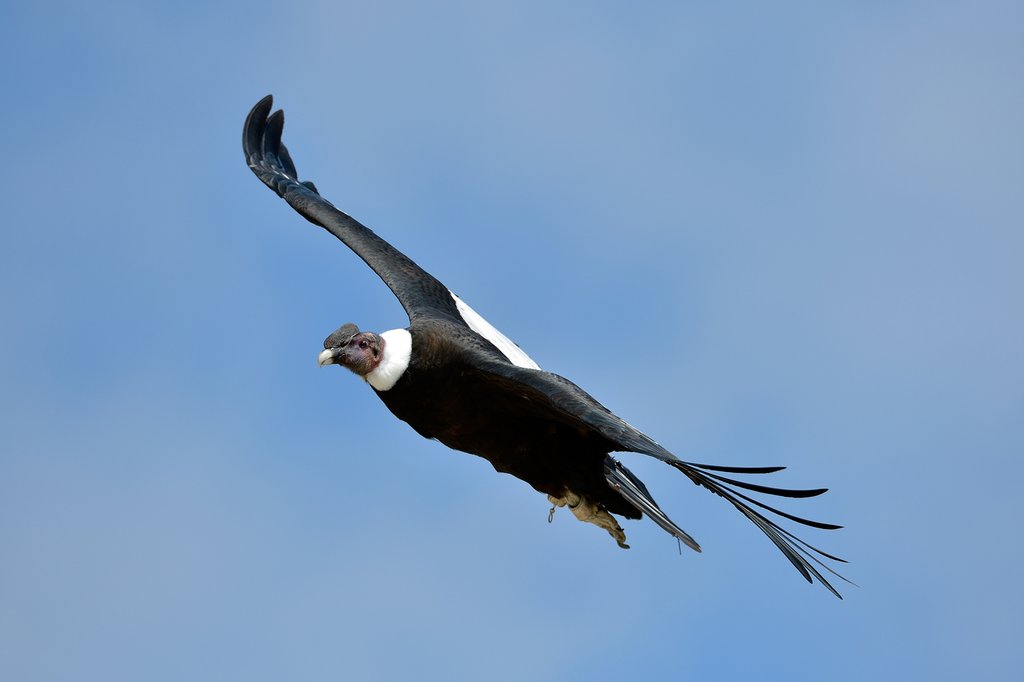
Trekking through the diverse landscapes of El Cocuy provides visitors with an unparalleled opportunity to witness an abundance of natural wonders. The park is renowned not only for its majestic snow-capped peaks that dominate the skyline but also for its towering cliffs, pristine glacial lakes shimmering in brilliant shades of aquamarine, and cascading waterfalls that plunge down rocky slopes. Here are some of the most stunning sights and attractions that the park has to offer:
Mountains and rock formations
The iconic Pan de Azúcar, which translates to “Sugarloaf,” is a prominent glacial peak that reaches one of the highest points within the park, standing at an impressive altitude of approximately 16,732 feet. Successfully hiking to the summit of Pan de Azúcar is considered a significant achievement and a “feather in the cap” for any experienced high-altitude trekker. Situated just below Pan de Azúcar is Cerro El Diamante, a distinctive rock formation that derives its name from its distinctive diamond-like shape. Trekkers who are fortunate enough to experience clear weather conditions at sunrise will be treated to a spectacular display as the rock face reflects the sunlight, creating brilliant flashes of gold, red, yellow, and orange. The Púlpito del Diablo (the Devil’s Pulpit) is a stunning rock mass that resembles an altar, rising dramatically from the landscape.
Some of the giant glacial peaks that beckon experienced climbers include Toti, which stands at 15,750 feet, and Ritacuba Blanco, the tallest peak in the park, reaching a towering height of 17,500 feet. Please take note of an important and pressing environmental concern: it is advisable to visit the glaciers of El Cocuy sooner rather than later. A 2013 report published by the Colombian Hydrological, Meteorological, and Environmental Studies Institute (IDEAM) issued a stark warning, predicting that all Colombian glaciers will have melted entirely by the year 2030 due to the effects of climate change. This makes visiting the glaciers of El Cocuy a poignant and urgent experience.
Lakes
Laguna de la Plaza is widely regarded as the most beautiful lake within the park. It is known for its stunning glassy blue surface that mirrors the surrounding peaks and its rugged and dramatic natural setting. Visitors to Laguna de la Plaza will be rewarded with breathtaking views of the imposing Pan de Azúcar and Toti peaks to the west. Laguna Grande de la Sierra is another picturesque body of water that offers equally stunning scenery. It serves as a great base camp for trekkers planning to ascend to the summit of either Pan de Azúcar or Toti. The clear waters and surrounding peaks offer stunning photo opportunities.
Valleys
The Valle de Lagunillas serves as the primary access point for reaching both the Pan de Azúcar and the Púlpito del Diablo. Within this valley, you will also find the route leading to the enchanting Laguna Grande de la Plaza. It also encompasses the Valle de los Frailejones, which is characterized by seemingly endless expanses of frailejón (Espeletia) plants, which are a ubiquitous and iconic feature of the park’s high-altitude páramo ecosystem. These unique plants, with their fuzzy leaves and distinctive appearance, are well-adapted to the harsh conditions of the high Andes.
Birding
Colombia is renowned for its exceptional avian diversity, with approximately 2000 species of birds endemic to the country. El Cocuy provides an excellent opportunity to observe a variety of these remarkable birds in their natural habitat. Even though the park is not specifically known as a dedicated birding destination, you can be sure to spot several beautiful highland páramo species, particularly around Laguna Grande. Some of the species you might encounter include the glossy flowerpiercer, the black-tailed trainbearer, and the Andean siskin. Furthermore, this region of Colombian páramo serves as the natural habitat and backyard of the country’s majestic national bird, the Andean condor. Keep an eye on the skies for a chance to witness this awe-inspiring bird soaring above the peaks.
Crafting Your Ideal Trek
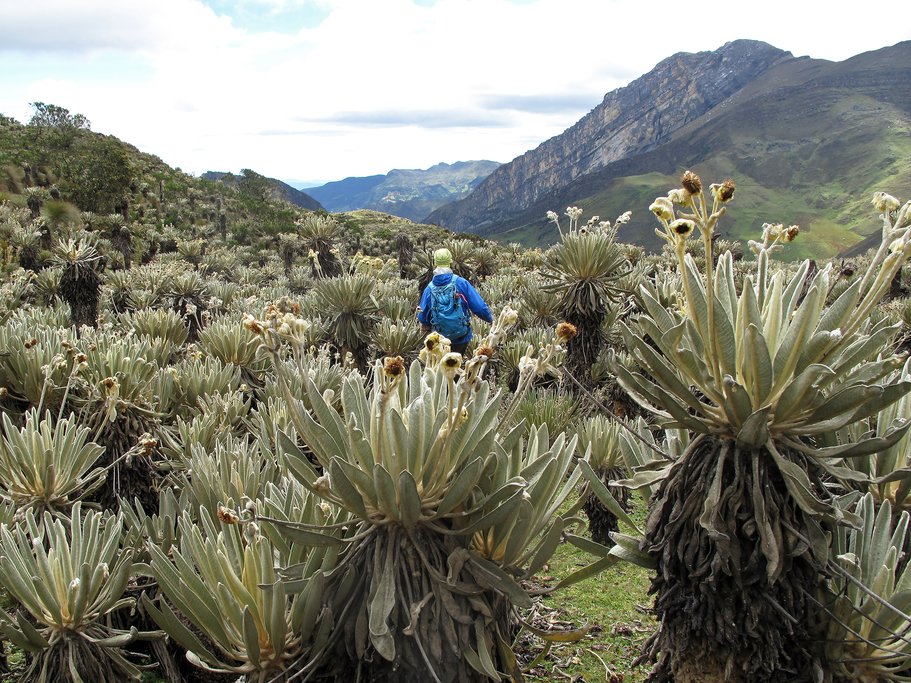
El Cocuy lends itself well to two distinct styles of trekking experiences. As mentioned previously, it is possible to undertake day excursions into the park. However, serious and experienced trekkers will likely prefer to plan for a more immersive experience, dedicating approximately a week of actual trekking to fully appreciate the park’s unparalleled beauty and majesty. In addition to the trekking days, you should also factor in additional time for transfers to and from Bogotá, as well as for acclimatization in the capital city and in the towns situated at the base of the park. Careful planning and preparation are key to maximizing your enjoyment of El Cocuy.
Day trekking
Day trekking in El Cocuy can be conveniently accomplished from any of the cabanas that are located on the outskirts of the park. This option requires minimal camping gear, making it a lighter and more accessible option for many visitors. That said, many of the cabanas and fincas, in addition to offering rooms and serving meals, also provide the option of camping on their grounds for a small fee. Popular day hike options include the trek to Laguna de la Plaza, which typically takes about 10 hours roundtrip, and the hike to Púlpito del Diablo, which takes approximately six hours roundtrip. These day hikes allow you to experience some of the park’s most iconic sights without the need for extensive gear or logistical planning.
Multi-day trek (6-7 days)
A multi-day trek of approximately 6-7 days allows you to experience all of the major highlights of the park in a comprehensive and immersive manner. However, it is important to be aware that this type of trek demands a good level of physical fitness and stamina. On this circuit, you will have the opportunity to visit the Valle de Lagunillas, Púlpito del Diablo, Pan de Azúcar, Laguna de la Plaza, Laguna Grande, the glacier peak of el Toti, Cerro El Diamante, and the Valle de los Frailejones. Be prepared to spend an average of 5-7 hours per day hiking, often over challenging terrain and at high altitudes. Adequate preparation, including physical conditioning and proper gear, is essential for a safe and enjoyable multi-day trekking experience in El Cocuy.
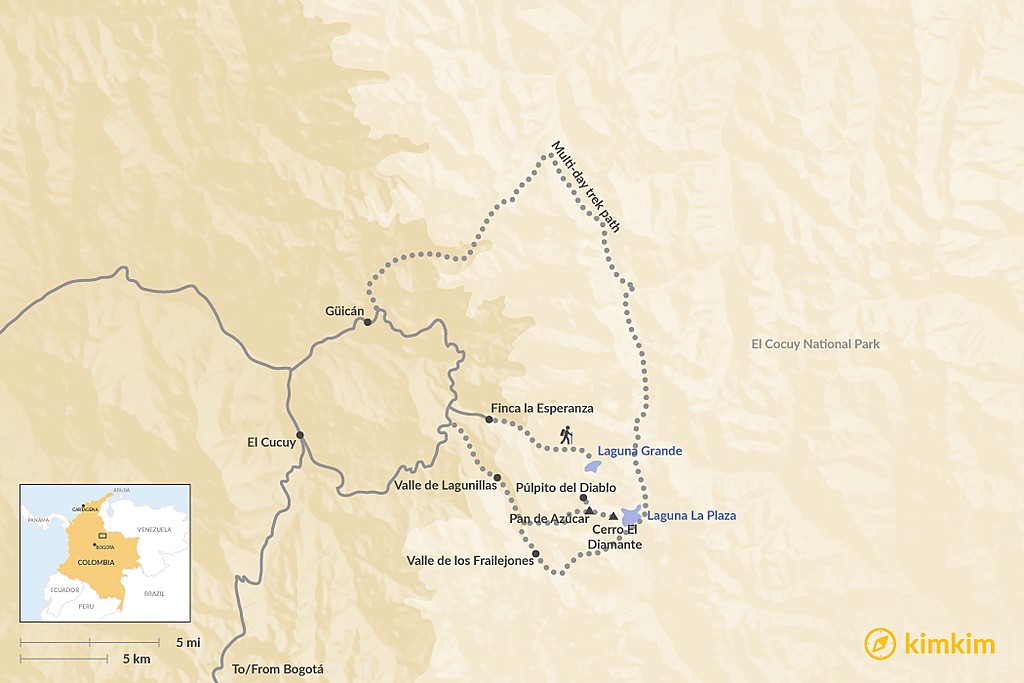
B-382

